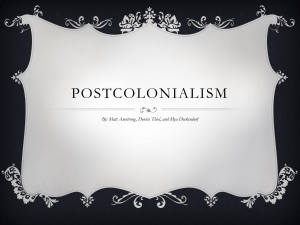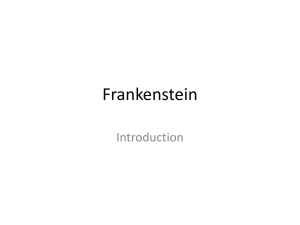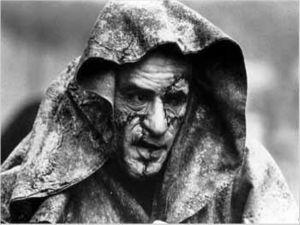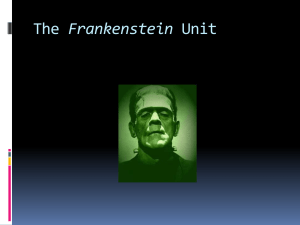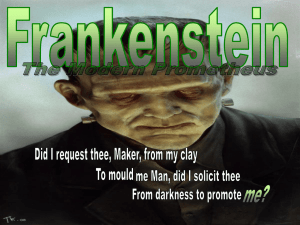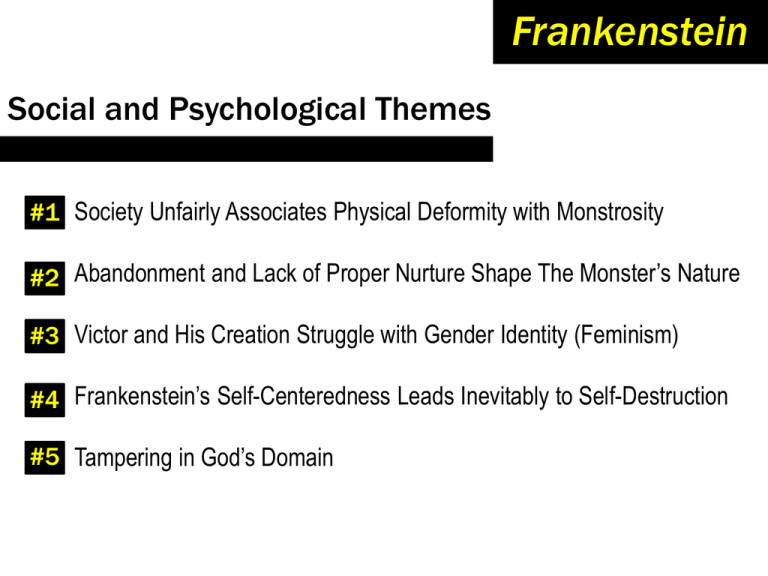
Frankenstein
Social and Psychological Themes
#1 Society Unfairly Associates Physical Deformity with Monstrosity
#2 Abandonment and Lack of Proper Nurture Shape The Monster’s Nature
#3 Victor and His Creation Struggle with Gender Identity (Feminism)
#4 Frankenstein’s Self-Centeredness Leads Inevitably to Self-Destruction
#5 Tampering in God’s Domain
#1
Society Unfairly Associates Physical Deformity with Monstrosity
Candidate #1 (Frankenstein) v/s
Candidate #2 Beyoncé
Let’s pretend that Blake Shelton is stepping down as one of the Judges on “The Voice.”
Executives have narrowed the field to these (2) CANDIDATES (“Monster” & Beyoncé).
Which one do you think will get the job?
Thank God for shows like “The Voice” where TALENT trumps Physique!
• Though the “creature” tries to educate himself
and aspires to become truly human―he cannot
overcome his physical “otherness.”
“Beautiful!―Great God! His yellow skin scarcely covered the work of muscles and arteries
beneath; his hair was of a lustrous black, and flowing; his teeth of a pearly whiteness; but
These luxuriances only formed a more horrid contrast with his watery eyes, that seemed
Almost of the same colour as the dun white sockets in which they were set, his shrivelled
Complexion and straight black lips.” (pg #56)
SHOW SLIDE #2 PHOTOS
PROBLEM?
Vision is key in Frankenstein.18th & 19th century Gothic literary genre emphasizes
the grotesque and mysterious in which visual codes were routinely used to identify
“good” from “bad” and socially acceptable from socially unacceptable.
Supposedly it was possible to tell if a person was “low class,” mentally inferior, or
sexually perverse simply by observing their outward appearance. The term “bad
blood” became code for racial inferiority.
We might ask ourselves ― Is this still the case today?
I would argue that it is, unfortunately, still the case today, but to a lesser extent. Today, we
are more accepting of people sporting extensive tattoos/multiple body piercings, etc. it’s been
mainstreamed. But in past years … Good luck getting a job sporting a pierced nose!
Moral message: Don’t judge a book by its cover!
• The monster in Frankenstein, establishes visual
horror as the main standard by which the monster
judges and is judged. The visual registers horror
while language confers humanity.
“ . . . Hear me.” (says Monster) (pg. #96-97)
PROBLEM?
“Monstrosity” is inextricably bound to textuality (language).
Within the language, monstrosity and humanity emerge as inseparable.
Example: old Mr. De Lacey represents the blindness of the reader. We are disposed
as readers to sympathize with the monster because, unlike the characters in the
novel, we cannot see him. Thus text (language) allows for compassion/humanity.
“ Begone! I will not hear you.” (says Victor) (pg. #97)
• Racial discrimination springs from the narrative.
Caroline notices Elizabeth in the poor family’s cottage because “she appeared of a different stock.”
Elizabeth is “thin and very fair” while the peasant children are “dark-eyed, hardy little vagrants.”
Elizabeth is also the daughter of a nobleman, fit, therefore, for adoption. Caroline adopts Justine also
But Justine must remain a servant since her heritage reveals no nobility. Birth, then, or blood rather,
separates one woman from another and prepares one for marriage and the other for service. The
difference between the noble and the debased is clearly exhibited in this instance upon the surface of
the body―Elizabeth stands out from the rest of her poor family because she is thin and fair. (pg #34)
PROBLEM?
Racism. Both Elizabeth/Justine adopted by Mrs. Caroline Frankenstein.
Discrimination is not limited to “creature.” Elizabeth/Justine, too, were judged visually.
Example: Elizabeth “appeared of a different stock.” (pg. #34) Justine/servant.
In Frankenstein, the “creature” and the women are measured against the supposed
“real human”—the Western European, bourgeois, male scientist.
Theme of visible monstrosity demands that identity be something that can be seen.
Even Aristocracy is feminized, thus inferior.
The Rights of Woman
by Mary Wollstonecraft
Published in London 1792
I
The Rights and Involved Duties of Mankind Considered Chronology
II
The Prevailing Opinion of a Sexual Character Discussed
III
The Same Subject Continued
IV
V
Observations on the State of Degradation to which Woman is Reduced by Various Causes
Animadversions on some of the Writers who have Rendered Women Objects of Pity, bordering on
Contempt
VI
The Effect which an Early Association of Ideas has upon the Character
VII
Modesty ― Comprehensively Considered, and not as a Sexual Virtue
VIII Morality Undermined by Sexual Notions of the Importance of a Good Reputation
IX
Of the Pernicious Effects which Arise from the Unnaturual Distinctions Established in Society
X
Parental Affection
IX
Duty to Parents
XII On National Education
XIII Some Instances of the Folly which the Ignorance of Women generates; with Concluding Reflections on
the Moral Improvement that a Revolution in Female Manners Might Naturally be Expected to Produce
Pernicious (per nish us) adj
Having the effect of destroying;
very injurious or destructive
Mary Wollstonecraft traveled alone through Europe and Scandinavia; more
important, she advocated in A Vindication that women be educated to be the
“companions” of men and be permitted to participate in the public realm by
voting, working outside the home, and holding political office.
#2
Abandonment and Lack of Proper Nurture Shape the Monster’s Nature
PROBLEM?
Jean Jacques Rousseau (a philosopher): his theory of the natural man
as a noble savage, born free but everywhere in chains and inevitably
• Victor abandons his “creature.”
corrupted by society. Theory ties to educating children.
“He [the “creature”] might have spoken, but I did not hear;
Example: “Other lessons were impressed upon me [says “creature”] even more
. . . I escaped, . . . .” [said Victor Frankenstein] (pg #57)
“Let your compassion be moved, and do not disdain me.” (pg#97) deeply. I heard of the difference of sexes; and the birth and growth of children; how
the father doated on the smiles of the infant, and the lively sallies of the older child;
“He [Victor Frankenstein] had abandoned me, and in the
how all the life and cares of the mother were wrapped up in the precious charge; how
bitterness of my heart I cursed him.” [said “creature”] (pg #127)
the mind of youth expanded and gained knowledge; of brother, sister, and all the
“He [the “creature”] might have spoken, but I did not hear;
various relationships which bind one human being to another in mutual bonds.” (117)
. . . I escaped, . . . .” [said Victor Frankenstein] (pg #57)
Example: “But where were my friends and relations? No father had watched my infant
BOOKS “Creature” Read: (pg. #124)
days, no mother had blessed me with smiles and caresses; . . . (pg. #117)
--Plutarch’s Lives of the Noble Romans he learns the nature of heroism and public
Mary Shelley had similar feelings of parental abandonment/Emotional Isolation:
virtue and civic justice.
--Volney’s Ruins, or A Survey of the Revolutions of Empires he learns the contrasting
Mom (Mary W.) dies (11) days after Mary’s birth. Dad (William Godwin) remarries in
nature of political corruption and the causes of the decline of civilizations. (115)
1801 [Mary Jane Clairmont who already had (2) kids of her own.] William/Mary Jane
--Milton’s Paradise Lost he learns the origins of human good and evil and the roles of
give birth to “Love-Will” William (Jr.) Coincidence that the Frankenstein character
the sexes.
named William, (5) years old, is strangled by creature? Maybe a little (Freudian-like)
--Goethe’s Werther he learns the range of human emotions, from domestic love to
suicidal despair, as well as the rhetoric in which to articulate not only ideas but feelings. half-sibling-rivalry going on! Same w/ half sister Claire Clairmont.
--Aesop’s Fables.
--Bible.
ALL OF THESE TEACHINGS CONTRAST WITH
VICTOR’S FAULTY EDUCATION.
• Mary Shelley’s ideas about proper nurturing and
education, which she deemed essential to growing into
a healthy, virtuous adult were shaped by these writings:
―17th century French philosopher Jean Jacques Rousseau
―17th century English philosopher John Locke
―18th century English physician/philosopher David Hartley
―”The Rime of the Ancient Mariner”/Samuel Taylor Coleridge
(poem influenced how Mary portrayed the “creature’s” loneliness.)
The “creature” knows that a child deprived of a loving family becomes a monster.
Ex: “I had feelings of affection, they were requited by detestation and scorn.” (pg. #?)
Ex: “I was benevolent and good; misery made me a fiend.” (97) “I was alone.” (127)
John Locke’s theory: Parents teach by their own example.
Locke even placed the health of the body and the development of a sound character
ahead of intellectual learning.
David Hartley’s theory: Early sensative experiences determine adult behavior.
“Creature” self-educates via books he found in an abandoned portmanteau (list).
These books helped with his moral development.
Rousseau favored constitutional democracy. Why? Once the “creature” leaves the
state of nature and learns the language and laws of society, he has gained a selfconsciousness that he can never lose, the consciousness of his own isolation:
“Oh, that I had forever remained in my native wood . . . (117) “What was I?” (118)
#2
Abandonment and Lack of Proper Nurture Shape the Monster’s Nature
PROBLEM?
(continued . . .)
In the late 18 c. and early 19 c. – there are political inequalities and
Nuclear structure of the De Lacey family
constitutes Mary Shelley’s ideal, almost perfect virtue.
Influence? Mary Wollstonecraft’s―
A Vindication of the Rights of Woman
The “creature” witnesses how the De Lacey family
takes care of one another and comes to understand
what’s missing in his own life (namely, love).
“This trait of kindness moved me sensibly.” (pg. 108)
Kindness begets kindness . . .
“When they had retired to rest . . . I went into the woods
and collected . . . fuel for the cottage. . . . I cleared their
path from the snow . . . .” (pg. 111)
• The De Lacey Family also abandons the “creature.”
“Creature” had called them “my protectors.” (pg. 124)
Symbolically, the “creature” turns his ‘gifts of love’
(firewood) back into raw fire by burning the De Lacey
cottage to the ground while dancing round it, himself
consumed in pure hatred and revenge. (pg. #134)
th
th
injustices based on the rigid and patriarchal/hierarchical gender divisions.
Mary Shelley introduced the De Lacey family, an alternative ideology, a
vision of a social group based on justice, equality, and mutual affection.
Example: Felix willingly sacrificed his own welfare to ensure that justice
was done to the Turkish merchant. (pg #119)
Example: In the impoverished De Lacey household, all work is shared
equally in an atmosphere of rational companionship, mutual concern,
and love. (pg #104-110)
Example: The female character, Safie is rightly appalled both by her
Father’s betrayal of Felix and by the Islamic oppression of women he
endorses. She shows a sense of independence when she flees from
Turkey to Switzerland, seeking Felix. (123) Safie, a female role model,
blossomed due to proper nurturing (despite being a female in a man’s
world). Safie’s Christian mother instructed her “to aspire to higher
powers of intellect, and an independence of spirit, forbidden to female
followers of Mahomet.” (120) Wollstonecraft reincarnated . Plus, Safie is taught
to read/write French in De Lacey family (education is a priority here).
PROBLEM?
Mr. De Lacey: “I am blind and cannot judge of your countenance, but
there is something in your words which persuades me that you are
sincere.” (pg. #130) Hearing only.
The others (Felix/Safie/Agatha) reject the “creature.” Vision only.
“Agatha fainted, and Safie …. rushed out …. Felix … struck me violently
with a stick.” (131)
PROBLEM? Missing a Mother’s influence (no Mrs. De Lacey).
She could have been the one to show some kind of compassion.
#3
Victor and His Creation Struggle with Gender Identity
(Feminism)
• Victor Frankenstein identifies Nature as female:
“I pursued nature to her hiding places” (pg #53)
“…she [Caroline] presented Elizabeth to me as her
promised gift” (pg #35)
[female as possession]
“I interpreted her words literally and looked upon Elizabeth
as mine …” (pg #35)
[female as possession]
• Victor has eliminated the female’s primary biological
function and source of cultural power.
“Victor’s creature becomes animated.” (pg #57)
• Frankenstein hopes to become the sole creator
of a human being.
Victor: Who needs women?
PROBLEM?
Victor participates in a gendered construction of the universe.
Victor’s scientific penetration and technological exploitation of female
nature is only one dimension of a more general cultural encoding of the
female as passive and possessable, willing receptacle of male desire.
PROBLEM?
Frankenstein has eliminated the necessity to have females at all. One of
the deepest horrors of this novel is Frankenstein’s implicit goal of
creating a society for men only: his creature is male; he refuses to
create a female; there is no reason that the race of immortal beings he
hoped to propagate should not be exclusively male.
Some critics say there’s an underlying homosexual argument here.
PROBLEM?
On the cultural level, Frankenstein’s scientific project (to become the sole
creator of a human being) not only tampers in God’s domain, but also
supports a patriarchal denial of the value of women and of female
sexuality. Mary Shelley, most likely, was influenced by her mother’s work
(SHOW SLIDE#6. Mary Wollstonecraft: A Vindication of the Rights of
Woman). This book specifically portrays the consequences of a social
construction of gender that values the male above the female
#3
Victor and His Creation Struggle with Gender Identity (Feminism)
(continued . . .)
• BATTLE OF THE SEXES (19th Century Genevan Society) PROBLEM?
Elizabeth is not permitted to travel with Victor –
She “regretted that she had not the same opportunities of enlarging
her experience and cultivating her understanding” (pg #?).
Inside the home, women are either kept as a kind of pet –
Victor “loved to tend” on Elizabeth “as I should on a favorite
animal” or they work as house wives, childcare providers, and
nurses or as servants (pg #?).
• SHOW SLIDE (#7)
Implicit in Mary Shelley’s attack on the social
injustice of established political systems is the
suggestion that the separation from the public
realm of feminine affections and compassion
has caused much of this social evil.
18th/19th century – It’s a man’s world.
Women belong in the home. Men in the public sphere.
Mary Shelley seems to agree with her Mother (Wollstonecraft). Reform!
• Intellectual activity is segregated from
emotional activity.
Victor’s obsession with his experiment has caused him “to forget
those friends who were so many miles absent, and whom I had not
seen for so long a time” (pg #53-54)
Frankenstein’s 19th century Genevan society is founded on a rigid
division of sex roles: the male inhabits the public sphere, the female is
relegated to the private or domestic sphere. So . . . What’s the problem?
MALE CHARACTERS
Alphonse F. – public servant
Victor – scientist
Clerval/& his Father – merchants
Robert Walton – Ship Captain/Explorer
FEMALE CHARACTERS
Elizabeth – homemaker
Caroline Beaufort Frankenstein – homemaker (V.’s Mom)
Margaret Saville– homemaker (R. Walton’s sister)
Justine Moritz – Servant
Norton Text: Had Elizabeth Lavenza’s plea for mercy for Justine, based on her
intuitively correct knowledge of Justine’s character, been heeded, Justine would not
have been wrongly murdered by the courts. Elizabeth exclaims: “how I hate [the]
shews and mockeries [of this world]! When one creature is murdered, another is
immediately deprived of life in a slow torturing manner; then the executioners, their
hands yet reeking with the blood of innocence, believe that they have done a great
deed. They call this retribution. . . .” (pg #?).
PROBLEM?
As a consequence of this sexual division of labor, masculine work is kept
outside of the domestic realm: hence intellectual activity is segregated
from emotional activity.
Essentially, Victor Frankenstein cannot do scientific research and think
lovingly of Elizabeth and his family at the same time. (see quote pg/ #53)
This separation of masculine work from the domestic affections
leads directly to Frankenstein’s downfall.
#3
Victor and His Creation Struggle with Gender Identity (Feminism)
(continued . . .)
• The doctrine of the separate spheres that Victor Frankenstein
PROBLEM?
Victor promised the “creature” a companion, but then breaks his promise.
endorses encodes a particular attitude to female sexuality that
WHY? At first, Victor was moved by the “creatures” full account of his sufferings and
Mary Shelley subtly exposes in her novel. This attitude is
aspirations (sympathy), and promises to create a female “creature” on the condition
manifested most vividly in Victor’s response to the creature’s
request for a female companion, an Eve to comfort and embrace him. that both disappear into oblivion. Victor goes to an isolated cottage on one of the
Orkney Islands off Scotland and proceeds to create a female being.
But second thoughts set in . . .
“You will return, and again seek their kindness, and
Example: Once again he becomes ill: “my heart often sickened at the work of my
you will meet with their detestation; your evil passions
hands. . . . my spirits became unequal; I grew restless and nervous” (pg #159)
will be renewed, and you will then have a companion
to aid you in the task of destruction. This may not be:
cease to argue the point, for I cannot consent.” (pg #142)
• What does Victor Frankenstein truly fear,
which causes him to end his creation of a female?
A FEMINIST STANCE ON VICTOR FRANKENSTEIN
Victor is first, and foremost, afraid of an independent female (a female
with desires and opinions that cannot be controlled by his male creature).
She might assert her own integrity and the revolutionary right to
determine her own existence.
Moreover, those uninhibited female desires might be sadistic.
Example: this female may choose to use her gigantic strength to
seize and even rape the male she might choose.
Example: Victor is afraid of this female’s capacity to generate an entire
race of similar creatures. A sexually liberated female would be Victor’s
worst nightmare! She would defy the sexist notion that insists women be
small, delicate, modest, passive, and sexually pleasing―but available
only to their lawful husbands. “Safie”/example of a liberated female.
#4
Frankenstein’s Self-Centeredness Leads Inevitably to Self-Destruction
Elizabeth’s and Justine’s unnecessary deaths
are directly attributable to Victor:
“I murdered her. William, Justine, and Henry –
they all died by my hands.” (pg. 179)
Victor Frankenstein’s self-devoted concern for
his own suffering (the creature will attack only
him) and his own reputation (people would
think him mad if he told them his own monster
had killed his brother).
• Critic Anne K. Mellor believes that Victor
Frankenstein cannot work and love at the
same time.
“The summer months passed while I was thus engaged,
heart and soul, in one pursuit.” (pg #53)
• Victor Frankenstein is fixated on himself.
No shortage of self-love.
PROBLEM? – BOTH GENDER ISSUE & SELF-CENTEREDNESS
Separation of gender spheres caused the destruction of many of the
women in the novel.
Example#1: Caroline Beaufort dies unnecessarily because she feels
obligated to nurse her favorite Elizabeth during a smallpox epidemic;
Caroline falls into the patriarchal ideal female self-sacrifice trap. Caroline
is a woman who is devoted to her father in wealth and in poverty, who
nurses him until his death, and then marries her father’s best friend to
whom she is equally devoted.
Example #2: Elizabeth, fully convinced of Justine’s innocence, is unable
to save her. Nor can Elizabeth save herself on her wedding night.
PROBLEM?
Because Victor cannot work and love at the same time, he fails to feel
empathy for the creature he is constructing and callously makes him
8 feet tall simply because “the minuteness of the parts formed a great
hindrance to my speed” (pg. # 52) He then fails to love or feel any
parental responsibility for the freak he has created.
PROBLEM?
Victor is so fixated on himself that he cannot imagine his monster might
threaten someone else when the creature swears to be with Victor “on
his wedding night” (pg. #183).
#4
Frankenstein’s Self-Centeredness Leads Inevitably to Self-Destruction
(continued . . .)
• Victor rejects the “creature’s” request for a female
companion, an Eve to comfort and embrace him.
“You must create a female for me, with whom I can live in the
interchange of those sympathies necessary for my being. This
you alone can do; and I demand it of you as a right which you
must not refuse to concede.” (pg. 140)
• Victor rationalizes his decision to deprive the
“creature” of a female.
• Victor does consider the possible damage
to man at the hands of these “creatures;”
but even then . . . his motive may be more
selfish than altruistic.
PROBLEM?
Victor initially promises to create a female, but then selfishly goes back
on his word: “I do refuse it. Begone! … I will never consent.” (pg #140)
PROBLEM?
Victor’s list of concerns if he continues creating a female ― none of
which take the male “creature’s” feelings into account: (selfish thoughts)
-- “She might become ten thousand times more malignant than her mate,
and delight, for its own sake, in murder and wretchedness.” (pg. #160)
-- The “creature” ‘shook hands’ on the deal to disappear . . . but this new
female “creature” may refuse a contract made before her creation.
-- Victor assumes the male/ female creature will get along. But the
reality is . . . they may not. They may hate each other. The male may
think the female “creature” is ‘ugly’ and reject it. Vice versa. The female
“creature” may prefer the ‘superior beauty of man.’
-- Reverse problem. They love each other and want to create a family of
their own!
PROBLEM?
Altruistic motive? Or selfish motive? You decide . . .
“Had I a right, for my own benefit, to inflict this curse upon everlasting
generations? . . . I shuddered to think that future ages might curse me
as their pest, whose selfishness had not hesitated to buy its own peace
at the price perhaps of the existence of the whole human race. (pg. 163?)
#5
Tampering in God’s Domain
• One critic (Timothy J. Madigan) calls the
fascination for/and drive to find the “secrets of
life” via newly created science/technologies ―
the “Frankenstein Impulse.”
“You seek for knowledge and wisdom, as I once did; and I
ardently hope that the gratification of your wishes many not be
a serpent to sting you, as mine has been . . . I imagine that you
may deduce an apt moral from my tale, one that may direct you
if you succeed in your undertaking and console you in case of
failure.” ―Victor Frankenstein
(pg #?)
• Many accuse Victor Frankenstein as having
the character defect of hubris [extreme
arrogance], attempting to be like God.
It can be argued that it’s Victor’s hubris that
causes his eventual downfall.
PROBLEM?
We, as a society, are naturally suspicious @ the “mad scientist”―often
condemning him/her for “tampering in God’s domain.”
Fears: Constant new discoveries in genetics.
Example: The FDA filed a lawsuit against the direct-to-consumer genetics
company “23&Me”(founded by a group of people including Anne
Woicicki/Sergey Brin, now divorced) Pressing motive for Inc.,: Brin’s
mother suffered from Parkinson’s disease . . . Brin wanted quick answers
and was willing to pay $$$s to get it. Helpful? Do you want to know?
Example: Multiple BioTech cloning manufacturers. Ethics anyone?
Example: Stem Cell Research . . . ties with Victor’s Question:
”Whence, I often asked myself, did the principle of life proceed?” (pg. #?)
Biologically speaking, some say . . . moment of conception. Others say
various stages of fetus development. Bottom line … Moral ambiguity.
Example: Abortion.
Example: Euthanasia.
My Thoughts . . .
My guess is that this character “defect” of hubris is common to
every risk taker . . . Whether in their work (i.e., inventing a new
product). or play (i.e., sky diving!). It’s a feeling of invincibility―
a philosophy that agrees with Romantics era of an individual believing
one’s above the crowd (a prophet) and must teach followers.
#5
Tampering in God’s Domain
(continued . . .)
• What does Mary Shelley think @ hubris?
• Can Victor Frankenstein be faulted for
playing God?
“I had so miserably given life.” (pg. 57)
What Does Mary Shelley think @ hubris?
HISTORY: (19) year old Mary Shelley was raised in a freethought
household. Her parents (Mary Wollstonecraft/William Godwin) were very
much Enlightenment rationalists. Progressive minds. Forward thinkers.
Married to poet Percy Bysshe Shelley [married 1816-1822].
Percy co-authored the pamphlet The Necessity of Atheism and Mary
was not reared in a pious religious tradition and had no qualms @
humans playing God. For her, no one had the corner market on human
creation.
Mary and Percy attended a science lecture (England Dec. 28, 1814).
This fact was recorded in Mary’s diaries. (3) yrs before Frankenstein
was published. Scientist: Andrew Crosse/attempted to bring life to
inanimate objects using electricity.
My Thoughts . . .
Yes. Mainly the fault is with Victor’s “cowardice and carelessness.”
Victor chooses to keep his creation a secret!
He flees his living “science project.”
Result? Good luck to any humans who might cross the path of this
dangerous “creature!”
Humans are naturally curious @ life. I agree with critics who say we just
need to keep the channels of communication open and direct our
scientific experiments/discoveries in a democratic and ethical direction.
Frankenstein
Social and Psychological Themes
Implicit in Mary Shelley’s attack on the
social injustice of established political systems
is the suggestion that the . . .
separation from the public realm of
feminine affections
and compassion
has caused much of this social evil.

